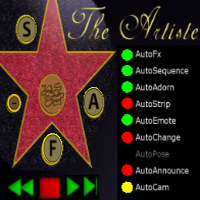Hi Everyone,
How are you all doing? I’m very well thanks.
The reason I post this is to comment on the recent performance and the making of the Girl On Fire video that will be linked in this brief summary and edited by Lat.
Ffirst, the making of the routine was a lot of fun. The hat-throw itself was an SL dance at first, not from the adorn point-of-view but the throw itself. Lat (Yummy) has done it before for the demo videos for everyone to learn from.
It was a subtle change from the original sword throw, to actually use it in a routine performed live at The Wolf Theater. Lat will cover all the aspects which I used in this routine so I won’t go over them as I know she is quite eager to do it.
Learning new things can be time consuming and to implement them into something thats original or that has not been done before is even harder to do at times while at the same time associating it with dance.
But the point is, it can be done. And the more complex you make a routine the quicker you feel gratification in the work you have accomplished,
If someone asked me to sum up the complexity of it, most is pretty easy. The hat, being the trickiest part of it all, really didn’t take long to do, building on the previous sword-throw. So, as the thrower is now, a few hours is all I need to make something throwable. That includes rotation, velocity, and distance. Anyone can do it but it takes time to learn so best of luck to everyone!. Oh I forgot the link
SarahRho Huntress
*******************************
Yummy here.
The preparation, creation, live-performance thru the making of the video conjured up a books-worth of ideas, thoughts, and emotions, but I will try hard to pare down my thoughts and be as concise as I can.
First and foremost this is the first effort and results from a person not only new to the Artiste but new to SL show-dance as well. This routine prioritized learning and using features of the Artiste over any other routine-creation-criterium. It is also the 1st live-show ‘throw’.
This effort shows some of what CAN be accomplished when a person:I think we have
isolated key factors required to become proficeint in the Artiste way of life.
1) sets aside a LOT OF TIME to learn,
2) PRIORITIZES learning and mastering tool-skills over performing and other distractions,
3) acquiring almost DAILY ONE-ON-ONE tutoring, and
4) really WANTS IT and BELIEVES in the RESULTS
***
Is all the effort worth it? I often ponder and wonder that. And even when answered, I realize the answer will be personal. What is worth it to one might not be worth it to another.
So, that is a question I cannot answer. Only a person like Sarah who has gone thru the ordeal can answer. I can never be “new” to the Artiste experience. I repeatedly asked her on several occasions and she always answered in the affirmative. Proof may well be in the pudding as she seems to have an unending craving for more Artiste feature-knowledge, experience, mastery, and practical application. Her enthusiam remains at an all-time high always trying to top her previous endeavors..
The focus on what has been done here should be placed on the mastering of intermediate and advanced Artiste skills in a relatively short span of time by a relative new-comer… more so than polish of a final product as she is new and should be allowed the time to grow and mature like all of us have had.
Tha Artiste is not an easy product to learn much less master but now I know that even with a new person and a reasonable amount of time…it CAN be done...with extreme sacrifices
Many of the accomplishments are visually apparent. Many will have significance only to those familiar with the internal machinations of the Artiste.
I will list the techniques that I identified in this performance:
1 – Dance-Sequencing
2 – Group-Dancing
3 – Cane-Adorn
4 – Group-Cane Adorn
5 – Hat-Swap (head-to-hand)
6 – HatThrow (Thrower) (1st live use in a show)
7 – Compound-Palette design (Fire Particle and Thrower)
8 – Sit-2-Sit
9 – Group Sit-2-Sit (Relay)
10 – Multiple Movers
11 – Lower
12 – Raise
13 – Extendibles (Extractions) (Phoenix) (1st live use in a show)
13 – SetRez
14 – SetSwap (HUD-sequenced control
15 – AutoCam design (1st live use in a show)
16 – HUD sequenced Curtain Control
17 - Rez Object (Palette)
18 - Kill Object (Palette)
18 down, only 182 more to go.
Lat (Yummy) Lovenkraft











